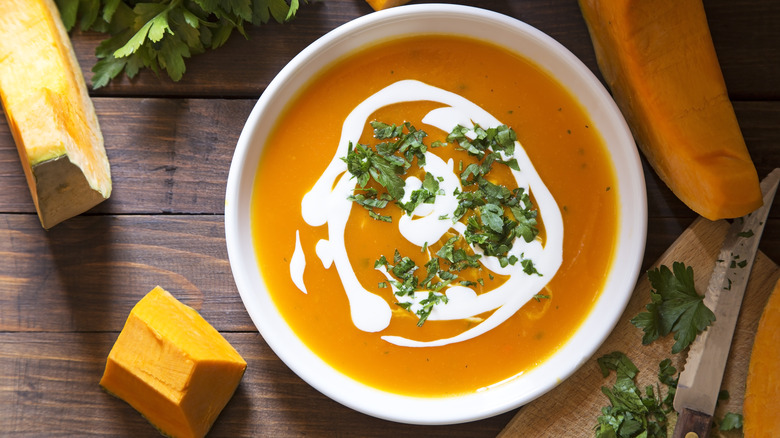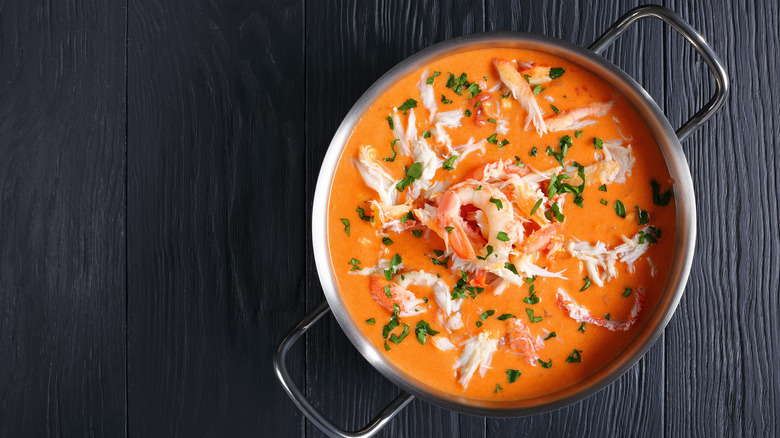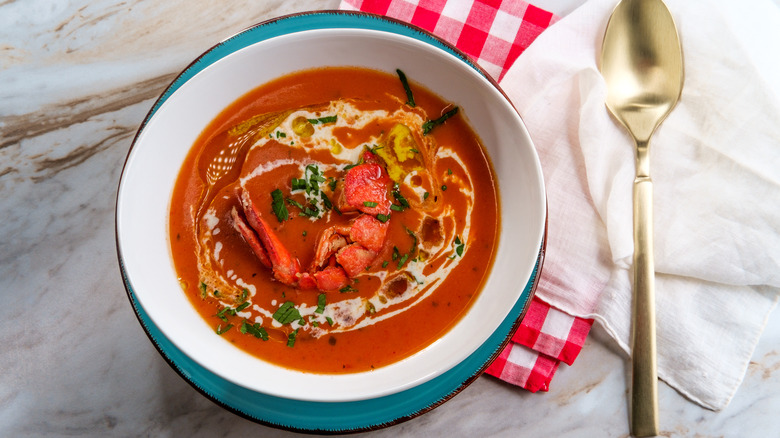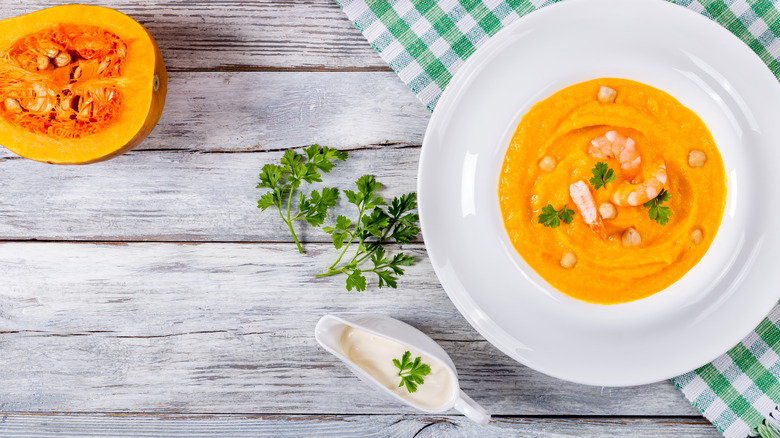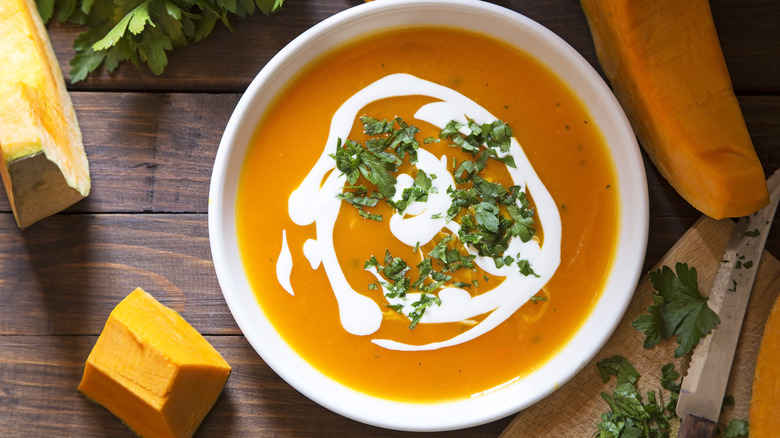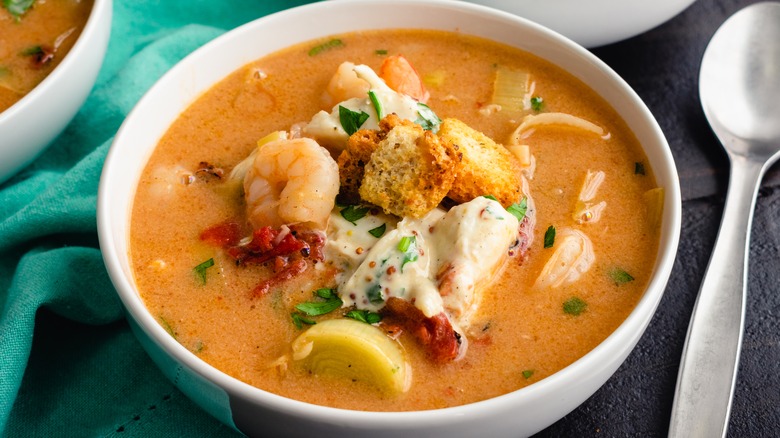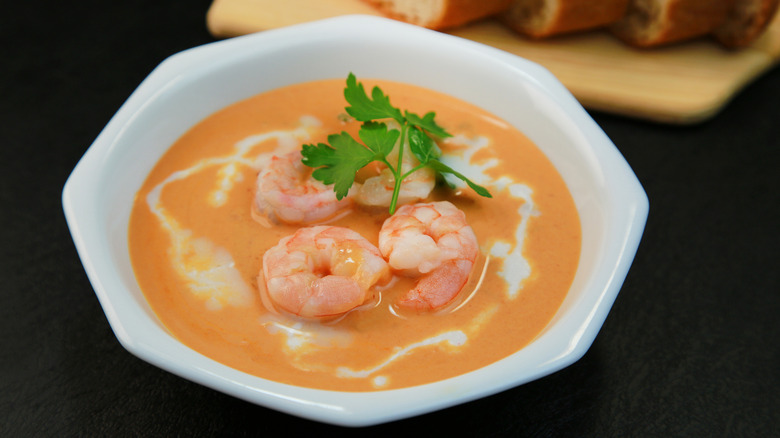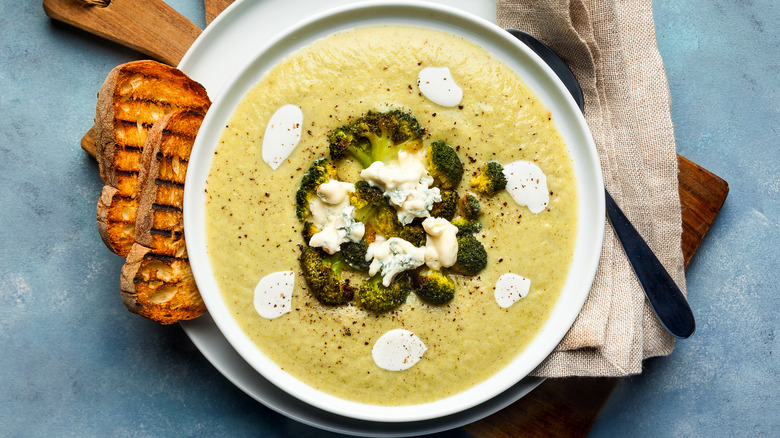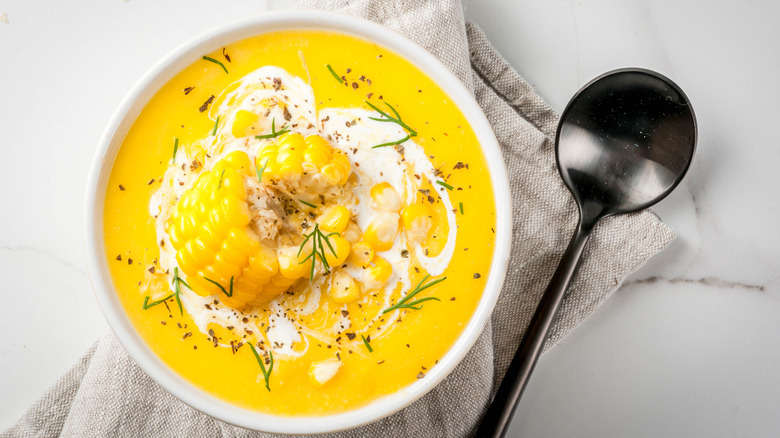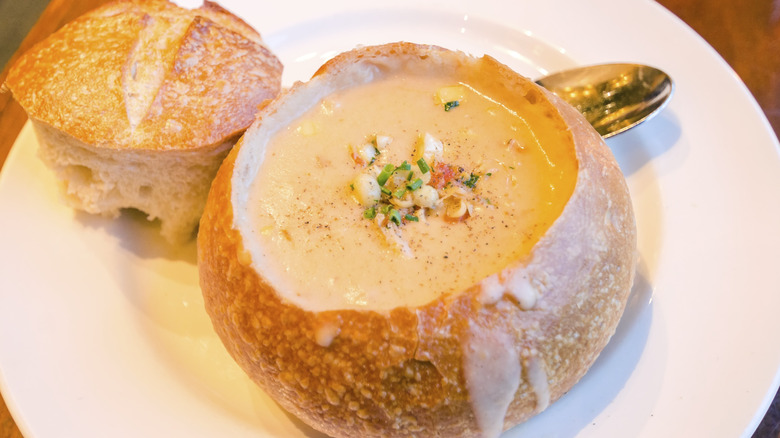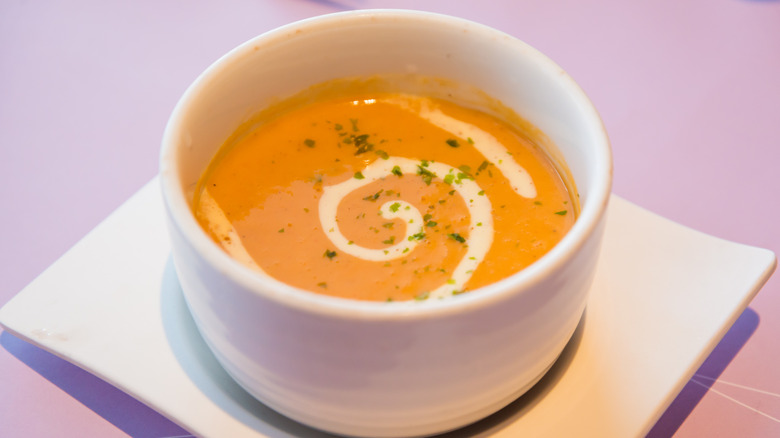10 Secrets For Making The Perfect Bisque
During the cold and dark winter months, there's nothing quite like a hot plate of food to warm your belly. Hot liquids, like bisque, stew, or classic hot chocolate, are all great ways to beat the seasonal chill. And while "bisque" might sound like a fancy way to say "soup," the reality is more complicated than that. As noted by FoodsGuy, all bisques are soups, but not all soups are bisques. In order to qualify for this unique title, a bisque should contain some combination of heavy cream and puréed ingredients. Unlike soup, which can have a fluid texture, bisques should be thick and velvety when served.
Because of its smooth consistency and rich flavors, bisque has become something of a multigenerational classic. One 1885 report found that there was so much demand for crawfish bisque in Paris that local restaurants had to procure key seafood ingredients at German markets (via The Animal Food Resources of Different Nations, p. 389). In modern times, bisque remains an integral part of fine dining — so much so that Solange Knowles served it at her wedding, (per US Weekly). As for the future of the side, an AI once even suggested it for an upscale yacht menu (per The Superyacht Chef).
Thanks to bisque's status as a longtime favorite, amateur chefs might consider whipping up a mouthwatering batch at home. By following a few handy tips, you can create the perfect bisque in your own kitchen.
1. Cook lobsters alive to make lobster bisque
These days, many folks associate bisque with fine dining. After all, lobster bisque is probably the most famous iteration of this starter, and the high price of seafood means it's not cheap to make. In the past, however, lobster bisque was hardly pricey. In fact, as noted by Origins of Food on YouTube, lobster was so cheap in colonial-era New England that it was considered a "bargain" meal. Some reports even indicate that lobster was used as fertilizer in the past.
One explanation for the lobster's transformation from a cheap dinner to a luxury item was that cooks stopped preparing the crustacean after its death. When a lobster dies, harmful bacteria spread through the animal's corpse, leaving humans with a high chance of contracting a food-borne illness called "vibriosis." From the colonial era to the 1800s, people prepared dead lobsters ... and suffered the consequences in their guts. By the latter half of the 19th century, however, cooks tried boiling lobsters alive (per ForknPlate). This culinary method decreased the risk of food poisoning, improved the meat's flavor, and eventually brought lobster into the world of fine dining.
When preparing lobster bisque, you can avoid health risks by cooking your lobster alive. To ensure that you choose the freshest specimen possible, check the crustacean's energy levels. The lobsters that are more energetic in the tank will taste better in your soup (via Summer Shack).
2. Add a dash of clam juice to lobster or crab bisque
If you are hoping to make your lobster or crab bisque taste a bit like the ocean, your main seafood ingredients might not cut it on their own. This is because neither lobster nor crab has a particularly salty or fishy flavor. On the contrary, lobster is, as a piece in the Detroit Free Press once put it, "uniquely mild." Meanwhile, two of the most popular crab varieties — King crab and snow crab — are both famous for having a touch of sweetness (via Oceanside Seafood). Because of this, it's easy for the seafood element of your bisque to disappear, especially after you add the neutralizing flavor of heavy cream. Unfortunately, for many home chefs, this means creating a bisque that lacks the taste of seafood.
Luckily, a secret ingredient will help you add a bit of oomph to your bisque: Clam juice. According to Delighted Cooking, clam juice is "a liquid strained from freshly shucked clams." Because of its strong briny flavor, clam juice is a key ingredient in seafood sides like golden clam chowder. It can also boost the ocean element in your bisque when added in small portions. To integrate this delightful ingredient into your bisque, you can start out with this lobster bisque recipe. Once you finish making the broth, add two to four ounces of clam juice for flavor.
3. Spice up your bisque with curry
When you eat a spoonful of high-quality bisque, the flavor shouldn't fall flat. On the contrary, it should draw you in and prepare you for the next course of your meal. After all, as explained by Meraaki Kitchen, soup courses are meant to prepare you for the heavier food items that come next. Soup even has a physiological impact on your stomach, prompting it to produce the enzymes that you'll need to digest your main course. Despite the importance of the soup course, however, many people overlook it — or even skip it entirely. One piece for Delicious went so far as to claim that eating soup feels repetitive, "like going to the gym and doing one exercise over and over again."
To make sure that your bisque doesn't get compared to push-ups, try to make it as attractive and enticing as possible. One way to achieve this is by adding a touch of curry, as this spice can give your soup course a uniquely deep taste in addition to a touch of color. Curry also works well in bisque since it combines perfectly with some of the other flavors that commonly appear in this starter. Shrimp, pumpkin, squash, and apple all taste fabulous with this earthy yellow spice. If you're interested in giving your soup course a fun and complex taste, try this recipe for curried butternut squash and pear bisque. Otherwise, add a few teaspoons of curry to your favorite bisque.
4. Add cinnamon or ginger to pumpkin bisque
It's no secret that cinnamon and pumpkin are an amazing combination. Whether in pumpkin bread, pumpkin pie, or even the infamous pumpkin spice latté, these two ingredients seem to go together perfectly. And pumpkin bisque is no exception to this rule. If you are hoping to prepare an autumn meal full of seasonal flavors, you can start out by whipping up a pot of classic pumpkin bisque. Then, add a dash of cinnamon and ginger. These spices will complement the sweet-and-savory taste of pumpkin and could even inspire your guests to think of fall.
In fact, science shows that the pumpkin-cinnamon combination does encourage us to remember the season. As explained in a report by CNN, "The part of your brain that processes smell is closely tied to the part of your brain responsible for memories." As a result, the strong scent of pumpkin mixed with cinnamon and ginger can stimulate your brain to remember autumns past. Researcher Sarah Cormiea, a doctoral candidate at Johns Hopkins University, told CNN, "Part of why [the smell of pumpkin spice] so strongly conjures the season ... is because if it were available year-round, it wouldn't have such powerful memories."
Because of this powerful association, a piping hot bowl of pumpkin ginger bisque could add a touch of fall nostalgia to your meal. To maximize this effect, serve your bisque with a classic fall drink.
5. Add some chopped prawns to your bisque
While adding spices to your soup is a great way to increase your guests' excitement, it's not the only way to upgrade your bisque. Garnishing bisques with large chunks of seafood can also go a long way toward making them look more appetizing. According to a study performed by British food scientist, Charles Spence, Ph.D., table guests believe that food with an artistic presentation tastes better than food with no visual frills (via The Guardian). This means that if your bisque looks beautiful, your guests will likely savor it more.
One way to improve your plating technique is by serving bisque with contrasting colors and textures. As California-based chef Joyce Tang explained in an interview with Lightspeed, "I like to play up contrasting textures on my plate ... The more time you spend on how you present each dish, the more visual interest you can stimulate in folks." Tang also noted that having contrasting shades on a plate is essential, although she recommends using "natural colors."
To create some contrast in your soup bowl, start out by making this simple shrimp bisque recipe. Then, chop up some cooked prawns and place a generous portion of meat in the center of each bowl. Here, the pale pink of the prawns will stand out against the warm yellow shade of the soup. The meat will also give your soup some texture that will elevate its visual appeal.
6. Thicken your bisque with crushed shells
At first glance, a shellfish's outer skeleton might not seem easy to integrate into a soup. Prawn shells, while edible, can have sharp edges, and are not easy to digest unless prepared in a specific way (via Epicurious). Meanwhile, lobster and crab shells are so dense that they require a nutcracker to open them. Nonetheless, shellfish shells have long been a key ingredient in seafood bisques. Traditionally, the soup's uniquely thick consistency was achieved through a two-part process that broke these shells down into a thickening agent.
First, cooks would boil a whole lobster or crab in water to create a stock. They would then remove the shells from the crustacean's meat and roast them under a layer of olive oil. Once the shells were cooked to a satisfactory point, they would grind them down into a paste, which they would subsequently mix with cream and add to the stock. The idea was that crushed seashells wouldn't just add some much-needed flavor to the bisque; they would also thicken its broth.
Interestingly, while this is no longer the most common way to prepare bisque, some people believe that this process inspired the soup's unique name. As explained in ForknPlate, the origin of the word "bisque" might boil down to the combination of two terms: "Bi" — which means "twice" — and "cuites" — which means "cooked." Since the shells in bisque are, effectively, cooked twice, this name would make sense.
7. Dress up your pear bisque with toppings
Although garnishes are great for a plate's presentation, they can also be used to add a boost of flavor to your soup course. When it comes to making pear bisque, in particular, you can use a garnish to give your soup a more complex taste and texture. This is because pear bisque has an extremely versatile flavor in the sense that it pairs well with lots of other flavors — no pun intended. As noted by The Devil Wears Salad, pear combines perfectly with spices like cinnamon or ginger, dessert items like caramel or chocolate, nuts like hazelnuts or walnuts, and even other fruits like apricots or apples. Consequently, you can get creative with the flavor combos in your garnish.
To make a pear bisque that nobody will ever forget, start out by reflecting on what flavors you want to accentuate in your soup course. If you want to make a hearty bisque full of delightful fall flavors, you might want to serve a fruitier garnish of chopped apples and cranberries tossed in cinnamon. If your goal is to make something more savory, you could try crumbling some gorgonzola cheese on top. For a pear bisque that can also be served as a main dish, you could add more caloric ingredients, like thin strips of Spanish jamón serrano and chunks of goat cheese, to your garnish. Before serving, artistically arrange the ingredients over your bisque.
8. Sprinkle corn on top of seafood bisque
While pear bisque goes well with plenty of flavor combinations, the same cannot be said about lobster or seafood bisque. Because of seafood's briny undertones, it won't necessarily work well with fall flavors like cinnamon or apples. Consequently, when choosing a garnish for seafood bisque, you might want to look for foods that have a sweet and buttery taste, as these accentuate the rich flavors of crustaceans like lobster, crab, or prawns.
Sweet corn makes an especially delightful garnish for seafood bisques since its natural sugars blend well with the softness of a shellfish's meat. As chef Geronimo Lopez revealed in an interview with San Antonio Express-News, "Corn has a mild sweetness to it that pairs well with scallops, shrimp, crab, and the lighter, less-oily fish types. You want to pair sweet with sweet." The chef also suggested cooking the corn a bit before adding it to your seafood meal. "We all love corn in shapes and forms. There is a definite umami flavor effect when the corn is charred that makes it pop," Lopez explained.
When buying fresh corn at the supermarket, try to choose the best-looking ear that you can find. After all, the fresher the corn, the more delicious your garnish will be. To choose the more flavorful fare, inspect the corn husk to make sure that it's tightly wrapped over the cob. You should also keep an eye on the color, as greener husks indicate higher-quality corn.
9. Serve your bisque in a sourdough bread bowl
A good garnish may go a long way toward improving the presentation of your bisque, but there's another way to up your plating game. Serving bisque in a sourdough bowl, rather than a porcelain one, is not only eye-popping — it's also delicious. The thick and chewy consistency of sourdough bread combines beautifully with thicker soups, like bisque. Because of this, a sourdough bowl can add some interesting texture to your guests' culinary experience.
Although making a whole bread bowl might seem like a complex task involving plenty of molding and shaping, it's actually relatively simple. In fact, this unique way of serving bisque is no more complicated to make than any other kind of sourdough. To make a sourdough bread bowl for bisque, start out by preparing this recipe for no-knead sourdough bread. When you remove the bread from the oven, let it sit on the cooling rack for a little bit more than an hour. Afterward, you can slice off the top of the bread and set it aside. Next, you can create a bowl by scooping the soft bits of bread out from the center of your loaf. Pour your bisque inside the bread bowl and — voilà — it's ready to eat.
As for the bread top, you can crumble it and sprinkle it over your bisque as a garnish. Alternatively, you can give it to your guests for dipping.
10. Be patient
They say that patience is a virtue, and when it comes to making bisque, that expression is definitely valid. Thanks to intensive steps like creating the stock, cooking the shellfish meat, and, ultimately, blending the ingredients, it is no small feat to prepare a high-quality batch of bisque. Because of this, however, many home cooks feel tempted to cut corners when preparing this starter. Unfortunately, this would be a huge mistake.
As explained in a piece for Real Simple, there is no good way to skip or modify steps when making a soup course. This reality is especially relevant for bisque. Store-bought stock often lacks the rich flavor of the homemade variety. Undercooked shellfish meat can give you food poisoning. And, a failure to blend your bisque thoroughly will leave it chunky and unpleasant. Consequently, the outlet reports, "Time and patience are the primary bases of any excellent soup or stew."
If you find yourself struggling with patience while cooking, don't worry. It is possible to switch your mentality. According to catering business owner Cathy Schmidt, you can boost your patience by focusing on the significance of your homemade meal. As Schmidt wrote in a piece for Attraction Mag, "I invite you to test your patience and create meaningful meal experiences." For Schmidt, this can mean selecting seasonal ingredients at the farmers' market or recreating a deceased relative's homemade recipe. The more meaning that you attribute to your cooking, the more patience you'll bring to the kitchen.
